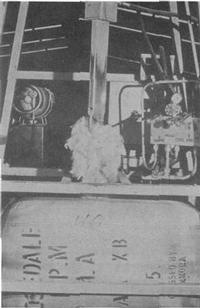


Chapter 5
I 1788 - State Of The Art In Textile Technology
II Australian Textiles - The Early Days
III Australian Textiles - The 20th Century
i Technology and Development
ii Australian Wool Textile Research
IV Australian Textiles - To Date
V Acknowledgements
References
Index
Search
Help
Contact us

Australian Wool Textile Research (continued)
Sale-by-sample was introduced as an optional marketing method for the 1972-73 season, after trials and demonstrations to acquaint all parties with the new techniques. It was quickly accepted, so that, after only a few years, the method was used to sell more than 95 per cent of wool sold at auction. In efforts to further accelerate sampling, researchers at the Sydney laboratory mechanized pressure coring by developing what became the Model T (for twin) coring machine.[29] Manual pressure-coring tools were only half the length of a bale, and samples had to be taken from both ends. The mechanized hydraulic version worked from only one end, using coring tubes that were 60 per cent of the length of the bale. The bale was temporarily compressed to about 70 per cent of its normal thickness to allow full-length samples to be taken. Machine sampling is always done through the base of the bale to avoid the metal clips used to close the bale's top.When sale-by-sample became a likely event, the researchers also developed a grab-sampling machine[30] that provided buyers with samples of uncut staples. By 1972, CSIRO had designed, built and tested prototype grab-sampling (Fig. 22), weighing and core-sampling machines and an automatic conveyor, ready for the commercial introduction of sale-by-sample.

The ultimate objective is to work towards the development of objective tests for the other properties of the fibre, with the intention of enabling sale by specification only, i.e. with no sample in view. The next step, however -currently (1986) under tria -is sale with additional measurements (SAM), but more of this below in its proper chronological order.
In scouring, the 1960s saw the increased adoption of synthetic nonionic detergents as replacements for the traditionally used soap-and-soda. This was aided by research at the Geelong CSIRO on both the efficiency of the different products available and other factors such as biodegradability. By the end of the 1960s, however, emphasis in scouring problems shifted rapidly towards effluent treatment. A typical scouring machine processing, say, 1 tonne of wool per hour in one year produces waste water with the same pollution load as that produced by a city of about 30,000 people. As awareness of the consequences of environmental pollution grew at this time, it was no surprise that pressure began to be applied for the 'polluter to pay'. This threw so much economic pressure on some scouring plants that the continued viability of wool scouring was questioned by some. While this concern proved unfounded, some plants did close or were re-located to areas with cheaper effluent disposal systems, albeit the costs of waste-water treatment may have been only one of the factors in such decisions.
The problem of treatment of wool scour wastes lies not only in the levels of pollution but also in the volume of the wastes. Scour liquors can be treated by the biological treatments used in conventional sewer works, but large plants are required. As charges for receival began to increase, so scourers began to look to some form of in-plant treatment to reduce these costs. In some cases, overseas, environmental requirements became so great that no discharge was allowed to leave the plant.
Organisations in Australian Science at Work - Australian Objective Measurement Project (A.O.M.P.); CSIRO; CSIRO Division of Textile Industry
 |
Australian Academy of Technological Sciences and Engineering |  |
© 1988 Print Edition page 288, Online Edition 2000
Published by Australian Science and Technology Heritage Centre, using the Web Academic Resource Publisher
http://www.austehc.unimelb.edu.au/tia/292.html